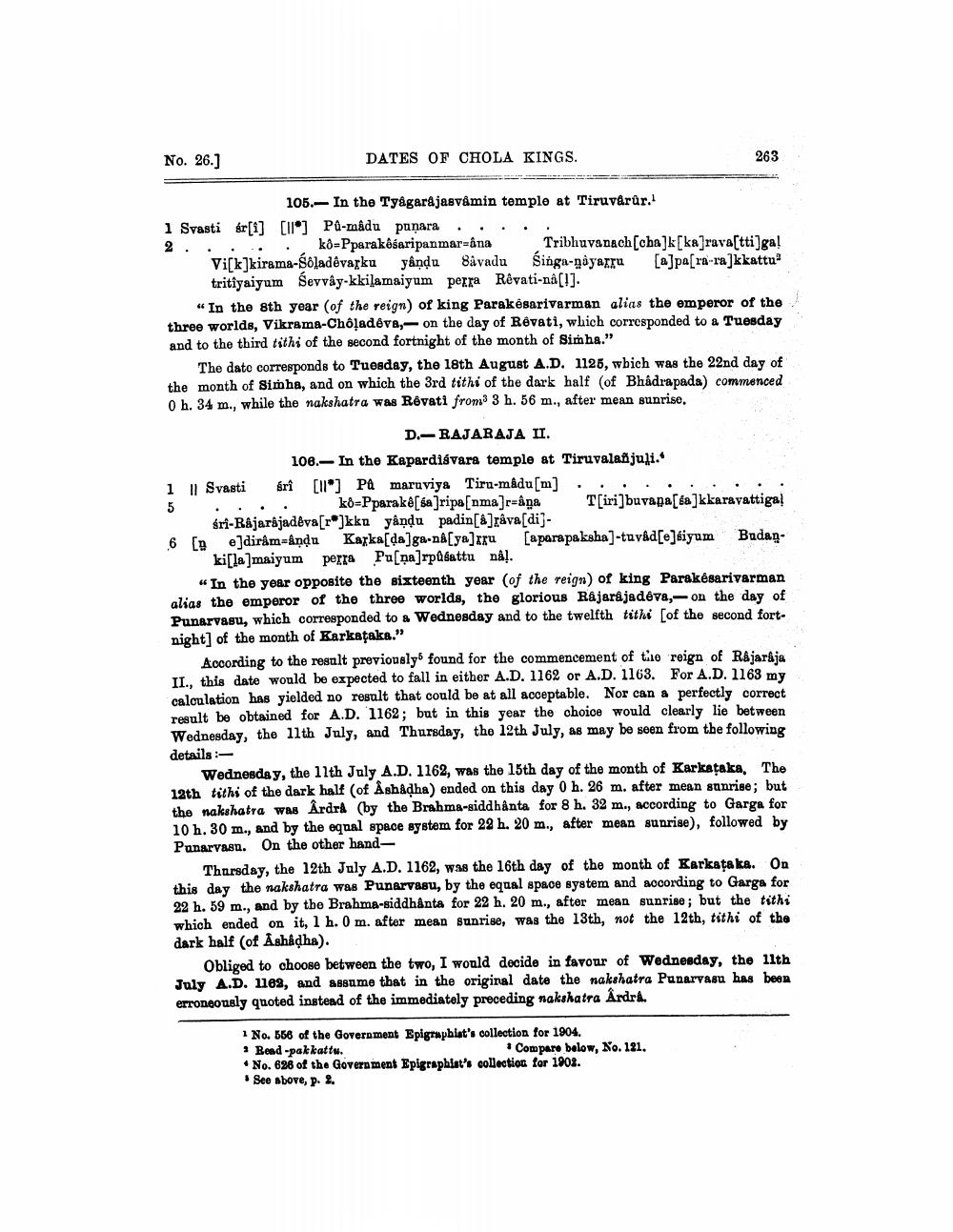________________
No. 26.]
DATES OF CHOLA KINGS.
105. In the Tyagarajasvamin temple at Tiruvârür.1
1 Svasti ár[i] [11] Pů-mâdu punara
2..
ko-Pparakiaripanmar-Ana Tribhuvanach [cha]k[ka]rava[tti]ga! Vi[k]kirama-ladóvarku yându 8âvadu Sing-gayar [a]pa[ra-ra]kkattu tritiyaiyum Sevvây-kkilamaiyum perra Rêvati-nâ[!].
"In the 8th year (of the reign) of king Parakesarivarman alias the emperor of the three worlds, Vikrama-Chôladéva,- on the day of Revati, which corresponded to a Tuesday and to the third tithi of the second fortnight of the month of Simha."
1 || Svasti
5
The date corresponds to Tuesday, the 18th August A.D. 1125, which was the 22nd day of the month of Simha, and on which the 3rd tithi of the dark half (of Bhadrapads) commenced 0 h. 34 m., while the nakshatra was Rêvati from3 3 h. 56 m., after mean sunrise.
6 [a
263
D.-RAJARAJA II.
106. In the Kapardisvara temple at Tiruvalañjuļi.
śrî [1] På maruviya Tiru-mâdu [m] kö-Pparak[a]ripa[nma]råga -Rajarajadva[r]kka ykodu padin[]riva[i]. e]dirâm=ându Karka[da]ga-nâ[ya]xxu ki[la]maiyum perra Pu[na]rpûsattu nâl.
[aparapaksha]-tuvâd[e]siyum Budan
"In the year opposite the sixteenth year (of the reign) of king Parakesarivarman alias the emperor of the three worlds, the glorious Rajarajadeva,- on the day of Punarvasu, which corresponded to a Wednesday and to the twelfth tithi [of the second fortnight] of the month of Karkataka."
T[iri]buvapa[a]kkaravattigal
According to the result previously found for the commencement of the reign of Rajaraja II., this date would be expected to fall in either A.D. 1162 or A.D. 1163. For A.D. 1163 my calculation has yielded no result that could be at all acceptable. Nor can a perfectly correct result be obtained for A.D. 1162; but in this year the choice would clearly lie between Wednesday, the 11th July, and Thursday, the 12th July, as may be seen from the following details:
Wednesday, the 11th July A.D. 1162, was the 15th day of the month of Karkataka, The 12th tithi of the dark half (of Ashadha) ended on this day 0 h. 26 m. after mean sunrise; but the nakshatra was Ardra (by the Brahma-siddhânta for 8 h. 32 m., according to Garga for 10 h. 30 m., and by the equal space system for 22 h. 20 m., after mean sunrise), followed by Punarvasu. On the other hand
Thursday, the 12th July A.D. 1162, was the 16th day of the month of Karkataka. On this day the nakshatra was Punarvasu, by the equal space system and according to Garga for 22 h. 59 m., and by the Brahma-siddhânta for 22 h. 20 m., after mean sunrise; but the tithi which ended on it, 1 h. 0 m. after mean sunrise, was the 13th, not the 12th, tithi of the dark half (of Ashadha).
Obliged to choose between the two, I would decide in favour of Wednesday, the 11th July A.D. 1163, and assume that in the original date the nakshatra Punarvasu has been erroneously quoted instead of the immediately preceding nakshatra Ardra.
1 No. 556 of the Government Epigraphist's collection for 1904. Read -pakkattu. Compare below, No. 121. No. 628 of the Government Epigraphist's collection for 1902. See above, p. 2.




